My vegan gyudon recipe is a no compromise rendering of the iconic savory, sweet and umami Japanese beef bowl. Think you can tell the difference between this plant based version and the gyudon served as late-night comfort food across Japan? Get your knives out and try it! Just 35 minutes to make from start to finish.
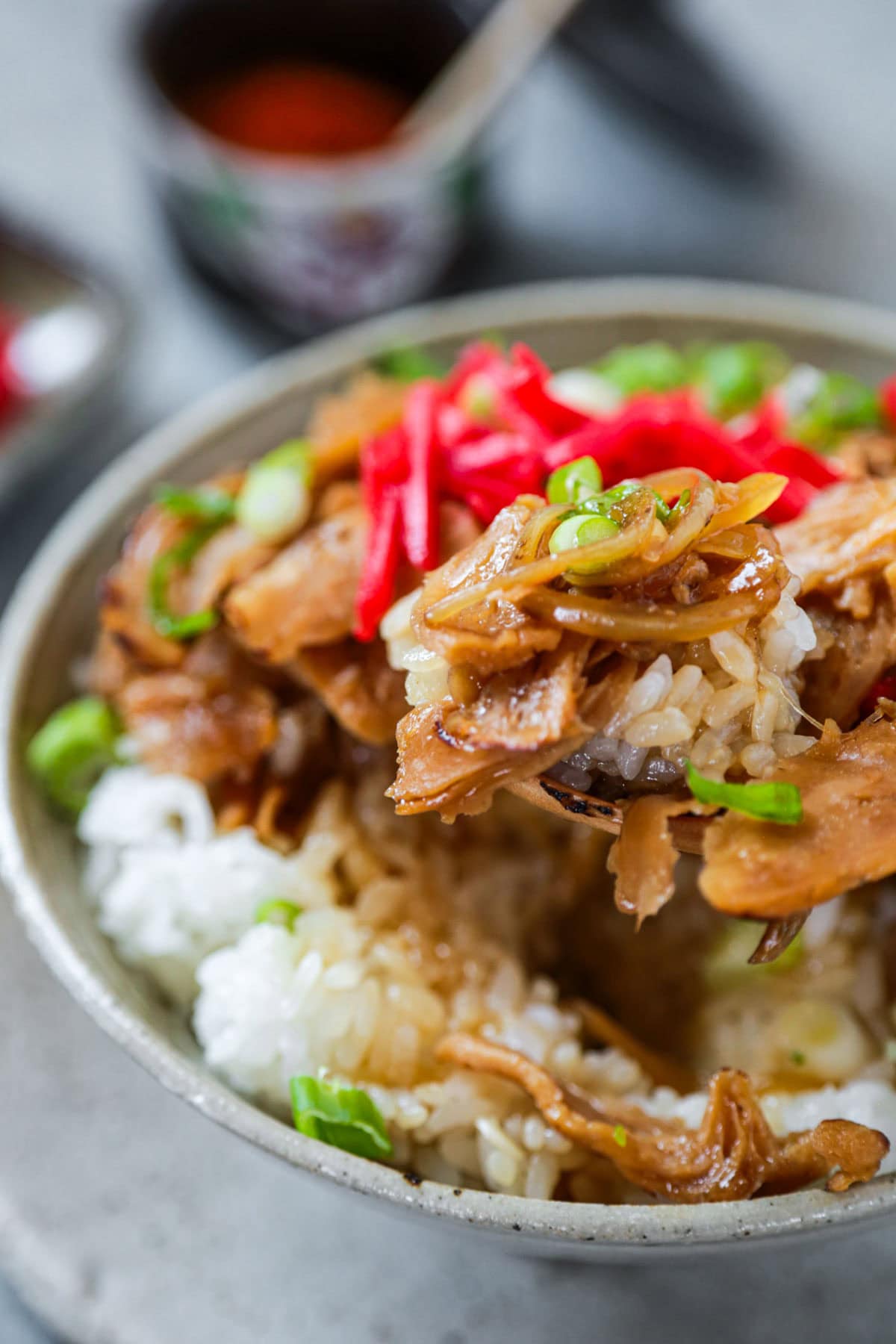
I used to stumble into Yoshinoya in Roppongi at 3am with friends just to get their legendary beef bowl. After a night out, there was usually a wordless agreement amongst us all that nothing could be better (in the world) than gyudon: thinly shaved beef and onions simmered in a savory, sweet, umami loaded sauce – served on top of a bowl of steamed Japanese rice. I was a sucker for the beni shoga – that bright pink/red pickled ginger. But since Ben and I don’t eat meat anymore, I have been missing it a lot.
So when I set out to make vegan gyudon, I did it with a promise: I vowed not to publish this recipe if it didn’t taste exactly like a proper Japanese beef bowl. When it comes to certain foods, ‘close enough’ just won’t cut it. I feel the same way about my Korean vegan bulgogi recipe, btw. After I got the seasoning just right, I took a bite and was instantly transported to those carefree nights out with friends.
Table of Contents
How I Made it Vegan
I’m using soy curls instead of the thinly sliced beef ribeye commonly used in gyudon. Then I simmer with onions in soy sauce, sake and mirin. What’s great about this recipe is that I didn’t have to make a ton of insane substitutions for the rest of the ingredients just to make it plant based. Aside from the protein, everything else is straight-up Japanese gyudon.
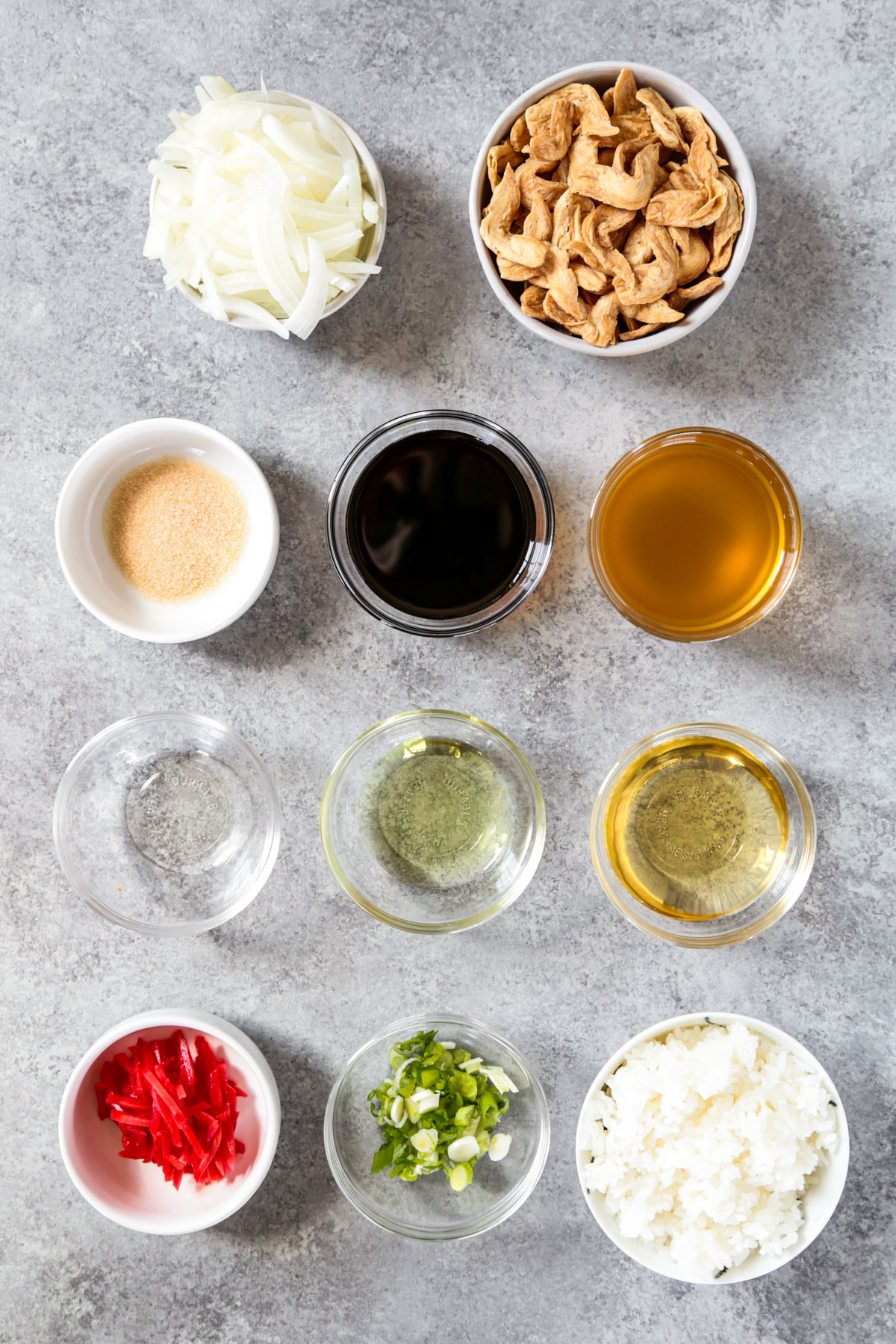
Ingredients
Scroll to the bottom of this page for the full recipe steps and measurements.
- Soy Curls or Soy Strips: This is soy protein. Once rehydrated, it has a soft, chewy texture and appearance very similar to chicken. Don’t worry, it’s a perfect stand-in for beef as well! These are the soy strips I used to make vegan gyudon.
- Onion: Finely sliced into half-moons.
- Oil: Use a neutral cooking oil. I prefer grapeseed oil. Vegetable oil works too.
- Broth: While vegetable broth is fine, I like to use mushroom broth for gyudon. It brings a bit more umami to the dish as a whole. But I also experimented making it with vegan dashi (kombu dashi) – which was also amazing.
- Soy Sauce, Sugar, Mirin and Sake: This essential Japanese combination makes up my savory, sweet and sharp gyudon sauce. And while it’s very similar to teriyaki sauce, I find that mixing it with the mushroom broth mellows the sweetness and brings out more umami notes. I prefer using a sake I like drinking on it’s own – but you can also use cooking sake, which has added salt.
- Green Onions: I finely chop these as a garnish.
- Japanese Rice: No beef bowl is complete without a perfectly steamed bowl of fluffy short grain Japanese rice.
- Pickled Ginger: This is called beni shoga in Japanese. It’s the pickled red ginger that is commonly served on top of guydon. I love the sweet, tart flavor.
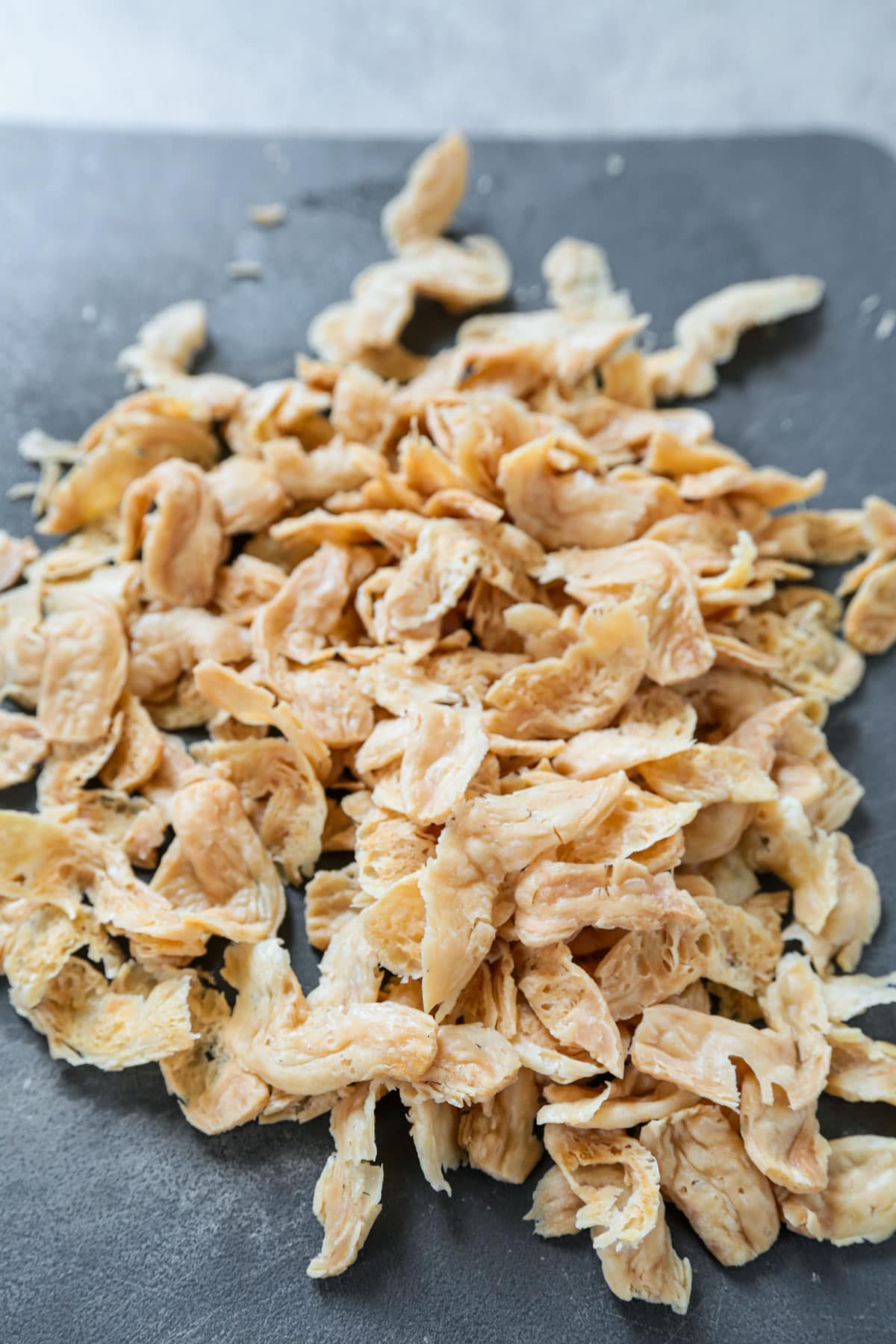
Expert Tip
Since the beef used in gyudon is shaved razor thin, the soy strips should be thin as well. After rehydrating and draining your soy strips, have a look. Are they plump? If so, I slice the pieces horizontally with a knife so they resemble the thinly sliced ribeye in gyudon.
If that sounds complex, just think of slicing a chicken breast lengthwise so you have two equal (but thinner) cutlets.
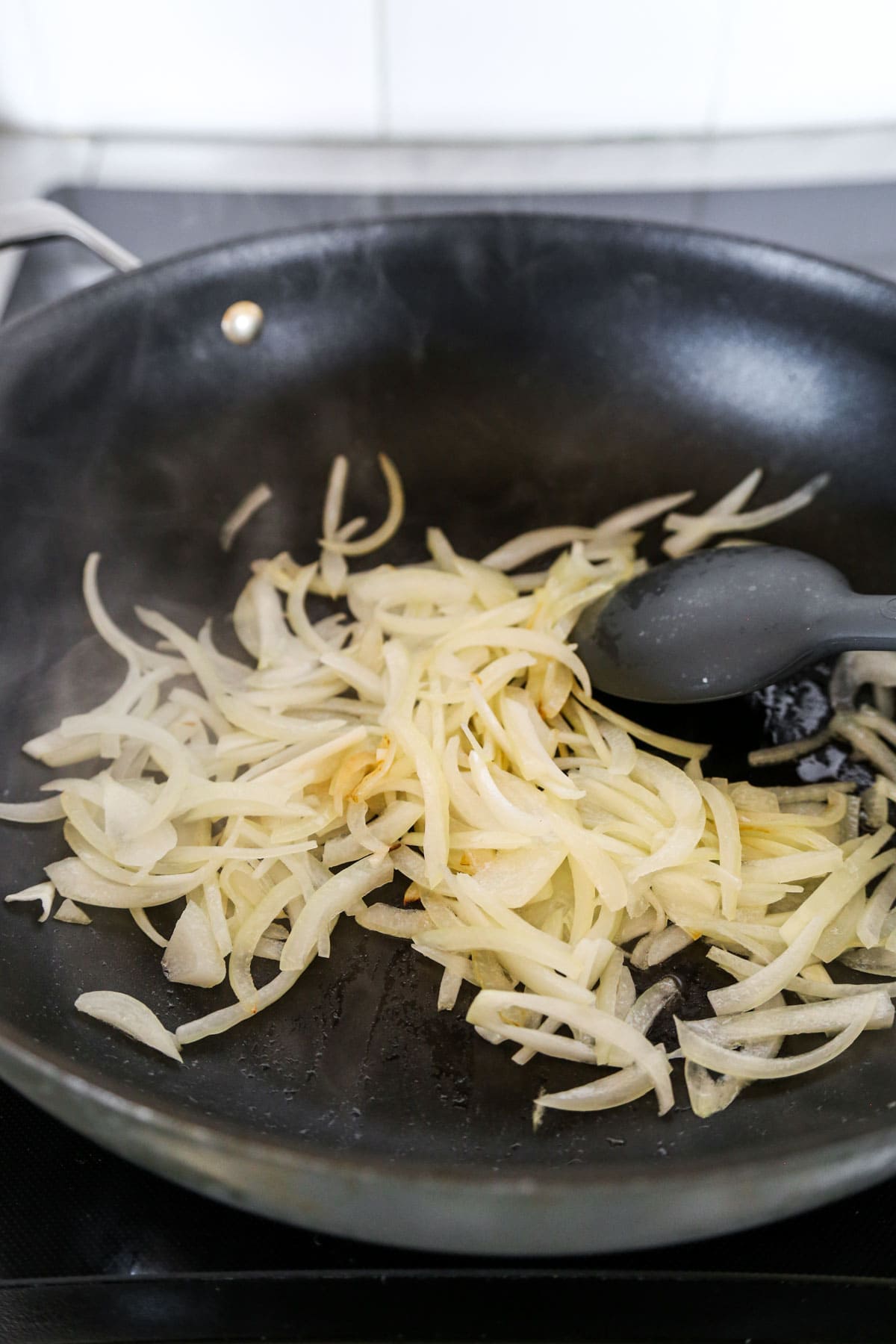
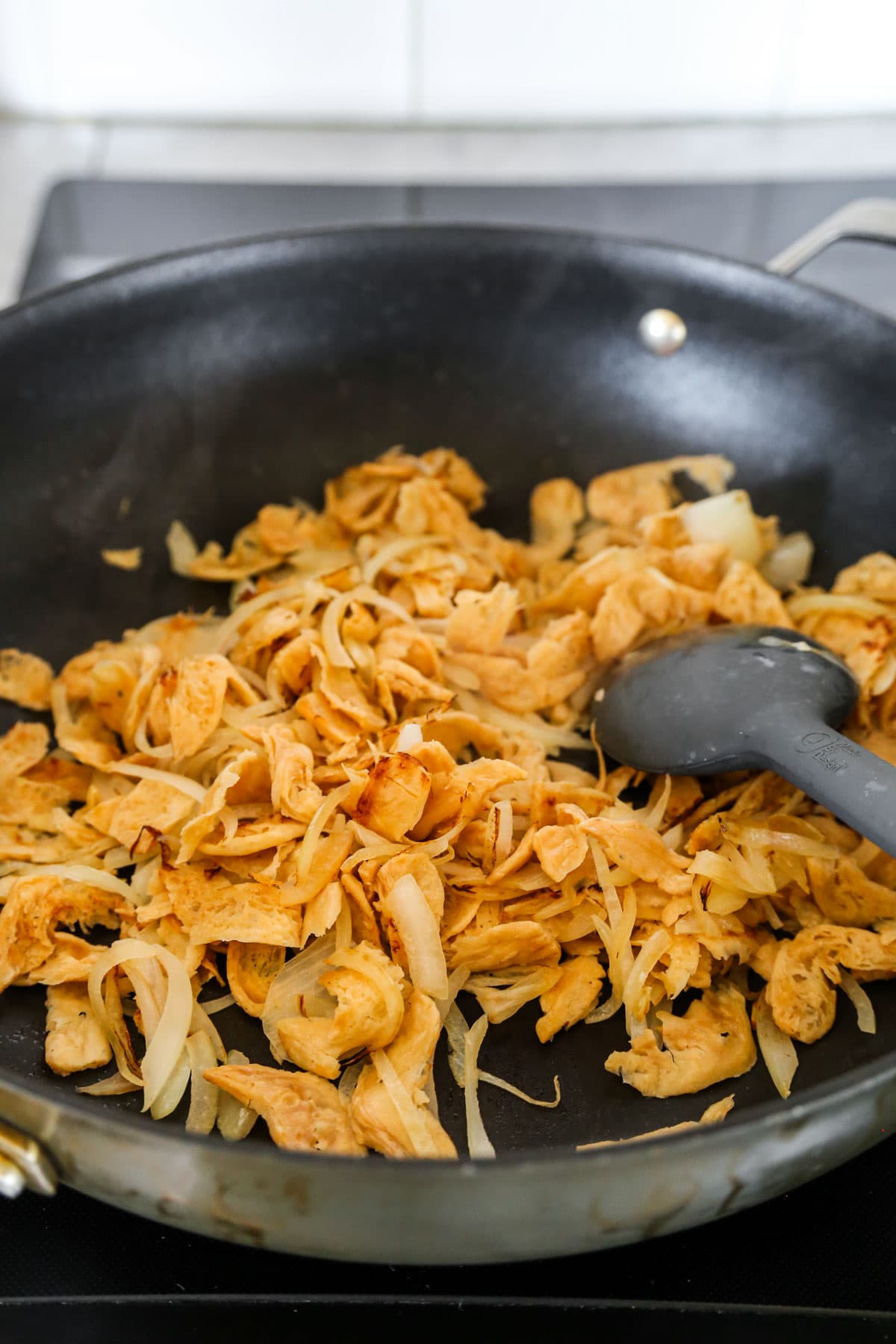
How to Make Vegan Gyudon
- Rehydrate and slice the soy curls. You want them to be soft. This usually takes me about 10 minutes in a bowl of warm water. Follow the timing instructions on the package for best results. If the rehydrated pieces look thick, slice them in half horizontally.
- Cook the onions and soy meat. Get a deep skillet going over medium high heat. Once hot, add the oil and sliced onions. Cook for 3 minutes, or until the onions have softened a bit. Then add the soy curls and cook for an additional 5 minutes.
- Add the sauce and simmer. Add the broth, soy sauce, sugar, sake and mirin and bring the mixture to a boil. Once boiling, turn the heat to low, cover with a lid and simmer for 10 minutes.
- Garnish and serve. Serve vegan gyudon over a a bowl of steamed rice. Garnish with green onions and pickled ginger.
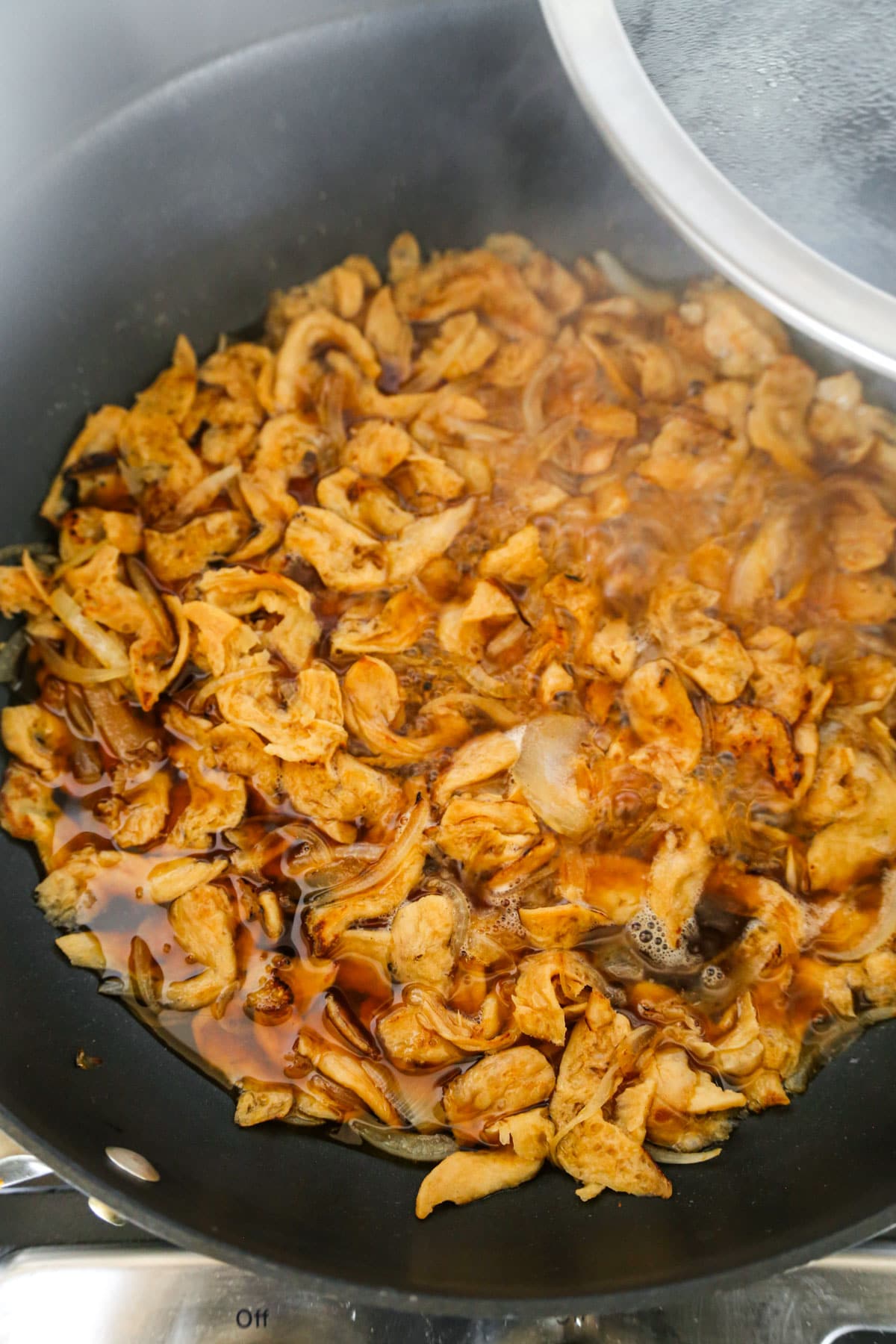
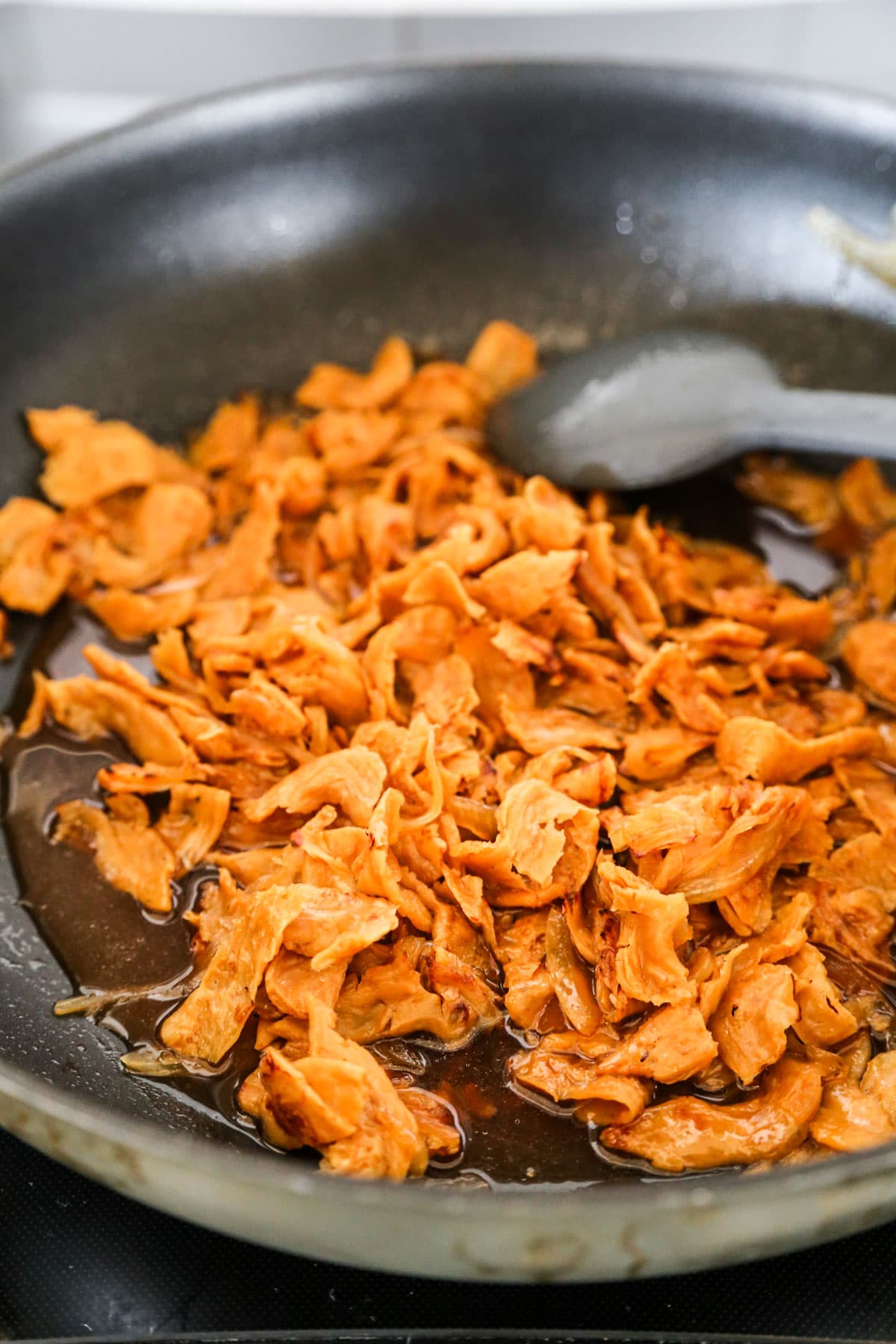
Recipe Variations
- Spice it up. You can sprinkle ichimi togarashi (ground Japanese dried chili peppers) on top of gyudon. It brings a little tingle, but isn’t overtly fiery. Another option I love is shichimi togarashi, which includes the dried chilis, but also has things like dried orange peel, ginger and sesame in the mix.
- Make it gluten free. The only ingredient that definitely contains wheat is the soy sauce. You can swap that out for liquid aminos or tamari instead. As always, it’s a good idea to read the label on any store bought soup stock, sake and mirin. While they shouldn’t contain wheat, some mass produced versions do.
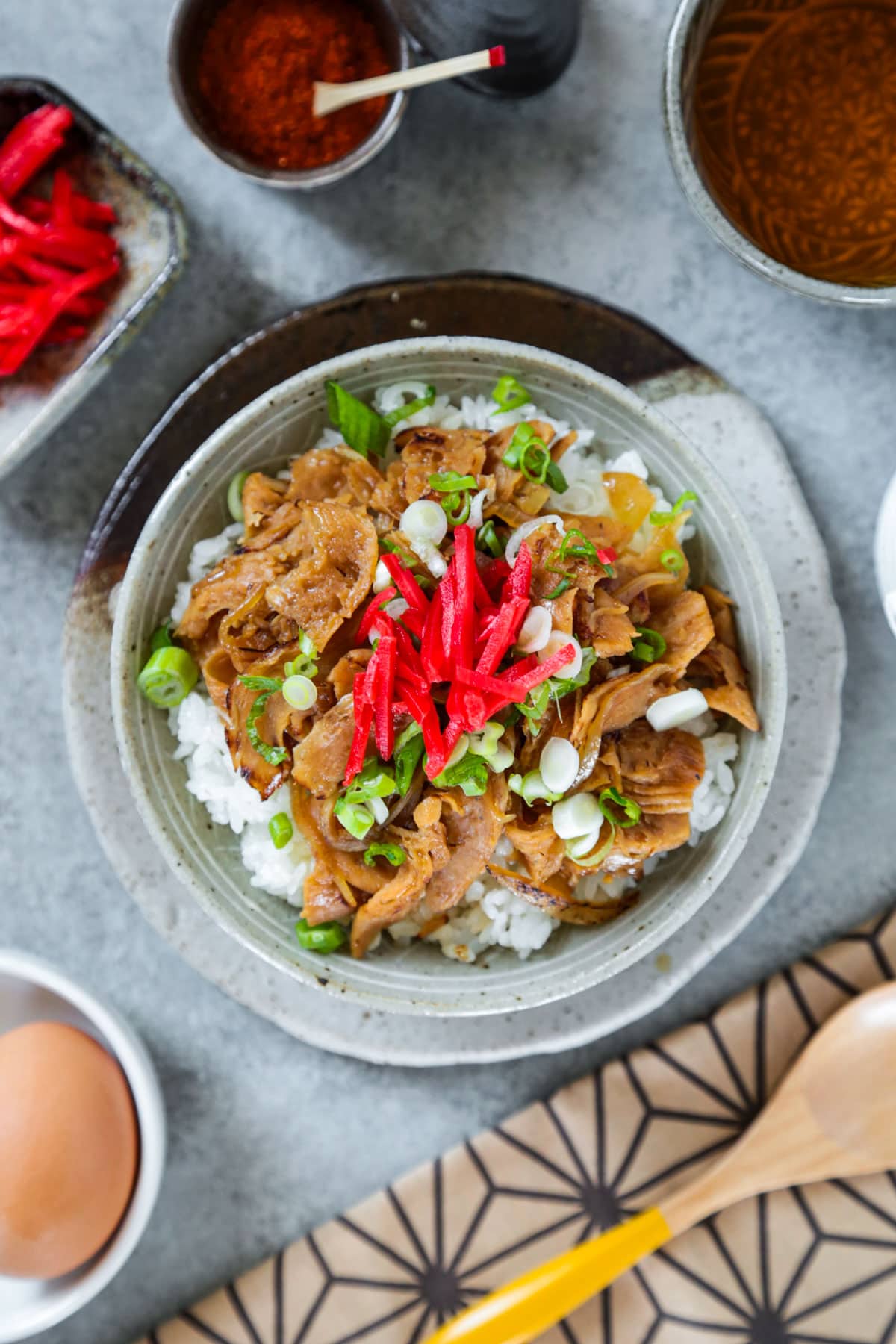
Storage
Store leftovers in the refrigerator (covered) for up to 3 days.
- I’m always sure to store the rice and gyudon in separate containers – so the sauce doesn’t waterlog my leftover rice.
- Reheat leftovers in the microwave. I like to top reheated gyudon with freshly chopped scallions and pickled ginger before serving.
Leftover soy curls can be frozen for up to 2 months.
What to Serve With Gyudon
What I love most about eating out in Japan is the teishoku – or meal set. Think of it as a value meal with pickles, soup, sides and a drink. And, even though most donburi (Japanese rice bowls) are fairly composed meals, they’re commonly served with small side dishes alongside the main attraction. Here are some of my favorites:
- Edamame With Soy and Sesame Sauce
- Miso Soup
- Nasu Dengaku – Miso Glazed Eggplant
- Japanese Pickled Cabbage
- Shiraae (Japanese Mashed Tofu Salad)
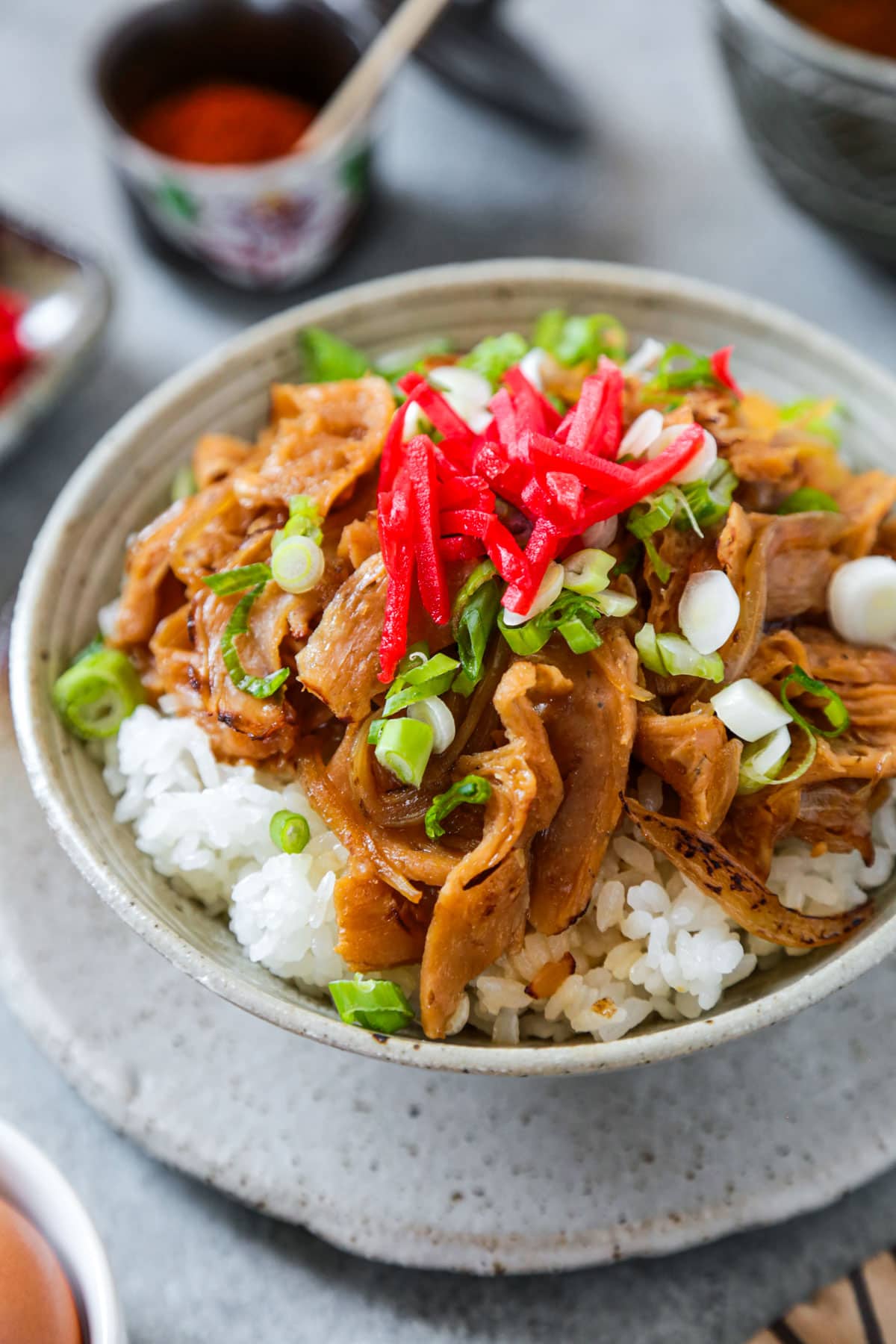
Frequently Asked Questions
They probably just need to sit in warm water longer to soften more. This happened to me when I used them the first time making plant based bulgogi. After I doubled up on the rehydrating time, they were perfectly fine. If they are still hard no matter how long they spend rehydrating, check the sell-by-date. If they’re expired, you may need to order new soy curls.
Beni shoga isn’t for everyone. My husband isn’t a big fan either. But he loves fresh ginger. So when I make gyudon for dinner, I garnish the rice bowls with pickled ginger for myself – and cut thin strips of fresh ginger for him.
Subscribe to my newsletter and receive the latest recipes and weekly favorites straight to your inbox. Join me on Pinterest, Facebook, and Instagram for more cooking tips and adventures!
Did you like this recipe? Are there changes you made that you would like to share? Share your tips and recommendations in the comments section below!
Print
Vegan Gyudon
- Prep Time: 15 minutes
- Cook Time: 20 minutes
- Total Time: 35 minutes
- Yield: 2 servings 1x
- Category: Main
- Method: Skillet
- Cuisine: Japanese
- Diet: Vegan
Description
My vegan gyudon tastes EXACTLY like a traditional Japanese beef bowl. Use soy curls instead of meat. The best Japanese comfort food!
Ingredients
- 1 cup soy curls
- 1 large onion, finely sliced into half moons
- 1 tablespoon vegetable or grapeseed oil
- 1 1/4 cup mushroom broth or vegan dashi
- 1 1/2 tablespoon granulated sugar
- 1/4 cup soy sauce
- 1/4 cup mirin
- 1 teaspoon sake
- 2 green onions, finely chopped
- 2 cups cooked Japanese rice
- Beni shoga (red pickled ginger), optional
Instructions
- Rehydrate, drain and slice the soy curls. Place the soy curls in a bowl with warm water and let sit for 10 minutes (follow specific rehydrating instructions in the package). The soy curls should be soft. Drain the soy curls and transfer them to a cutting board. Thinly slice the soy curls so they look like thinly sliced meat.
- Cook the onions. In a deep skillet over medium high heat, add the oil. When the oil is hot, add the onion and cook for 3 minutes, until the slices have softened a little.
- Cook the soy meat. Add the soy meat, stir, and cook for an additional 5 minutes.
- Add sauce and boil. Add the broth, sugar, soy sauce, mirin, and sake, and bring the mixture to a boil.
- Lower heat and simmer. Turn the heat to low. Close with a lid and simmer for 10 minutes, or until the onions are soft.
- Garnish and serve. Turn the heat off and serve the gyudon over rice. Garnish with green onions. Serve with beni shoga (pickled ginger).
Notes
Store leftovers (covered) in the refrigerator for up to 3 days.
Nutrition
- Serving Size: 1 serving
- Calories: 563
- Sugar: 32g
- Sodium: 1365mg
- Fat: 9.6g
- Saturated Fat: 5.7g
- Unsaturated Fat: 0.3g
- Trans Fat: 0g
- Carbohydrates: 98.9g
- Fiber: 6.9g
- Protein: 19.7g
- Cholesterol: 0mg

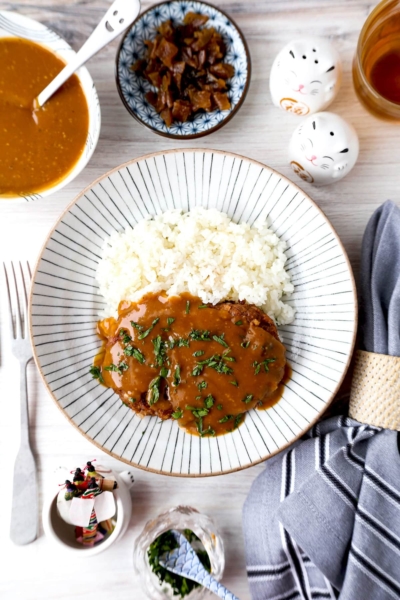

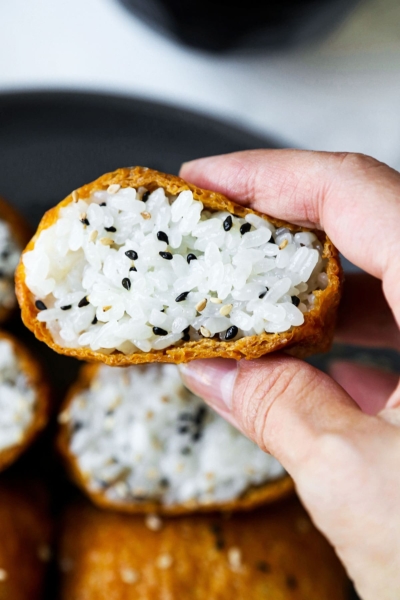















Questions and Reviews
Hi! I wonder if you also managed to achieve the texture similar to gyudon with the soy curls in your recipe? I am not sure how to best emulate the melt-in-your-mouth texture marbled beef offers.
Hi Alexandra! The texture isn’t melt-in-your-mouth tender like beef but is really similar overall, with the chewiness of beef. The flavors are almost the same as a classic bowl of gyudon too 🙂